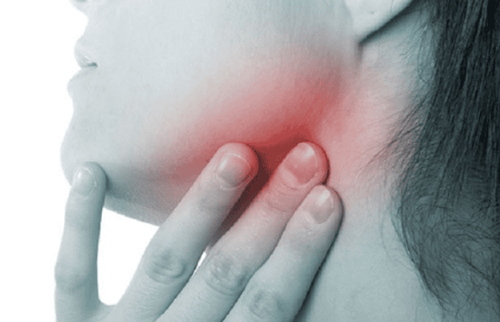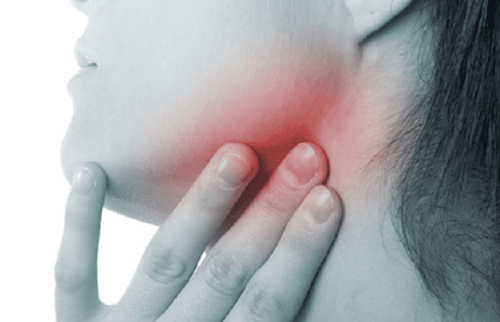This is an automatically translated article.
The article was professionally consulted by Specialist Doctor II Nguyen Khanh Nam - Doctor of Odonto-Stomatology - Department of General Surgery - Vinmec Nha Trang International General Hospital.The submandibular gland consists of two salivary glands located below the jawbone, which play many roles in activities of daily living. However, if these glands are obstructed, congenitally narrow, or have serious infections, the patient is often indicated for submandibular glandectomy.
1. Anatomy of the submandibular gland
The submandibular gland consists of two salivary glands located below the jawbone and above the biceps muscle. Each gland is divided into 2 lobes, the superficial and the deep, separated by the hyoid muscle.Saliva produced by the submandibular gland is directed into the Wharton duct in the superficial lobe, drinks around the posterior edge of the hyoid hyoid muscle, and continues to move across the lingual nerve, finally emptying into the sublingual nipple for drainage. go out.
Functions of the submandibular gland are relatively diverse because the mucus-secreting cells in the submandibular gland have distinct roles, including the following activities:
Production of saliva: about 70% of saliva is secreted from submandibular line. Generates amylase enzyme: this is an enzyme that helps digest starch from the mouth and converts starch into glucose before it enters the stomach. Mucin secretion: mucin acts as a food lubricant, making it easier for food to move through the esophagus into the stomach.
2. What is submandibular gland surgery?
A submandibular glandectomy is a surgical removal of the entire submandibular gland, which may be aimed at treating pathology or as a prerequisite surgery, paving the way for other surgeries.3. Under what subjects is submandibular surgery performed?

Patient has inflammation of the submandibular gland, which frequently recurs and cannot be definitively treated by medical methods. The patient has a tumor or stone in the submandibular gland. Ductal stenosis after procedures on the floor of the mouth or after radiation therapy. As part of a cervical lymphadenectomy. Patients need to pave the way to perform surgery on the floor of the mouth or the side of the pharynx. However, some of the following patients are in the group of contraindications for submandibular surgery:
Have severe medical disease. CKD . Have blood problems. There is an acute inflammation in the body. The patient is not healthy enough to perform surgery.
4. What preparation is required before submandibular gland surgery?
Before being indicated for submandibular surgery, the patient should have an otolaryngoscopy examination and complete the following tests:Blood count test to prepare for blood transfusion when needed. Basic coagulation tests. Check liver and kidney function. In addition, the patient will also have a CT - Scanner of the neck area in 2 positions tilted and straight.

5. Follow-up issues – post-operative care of submandibular gland surgery
Patients after surgery to remove the submandibular gland will be monitored and drained after about 48 hours. Every day, the patient needs to change the dressing as well as clean the incision properly. If the wound has a good healing rate, the patient can remove the sutures and leave the hospital after about 5-7 days after surgery.After discharge, for the first week, the patient should rest and avoid vigorous activity. However, after this time, you should start exercising again to help your body quickly return to normal activities. Most patients have a good recovery and few dangerous complications.
Some possible complications: Bleeding: the postoperative incision as well as the drainage vessel should be monitored to detect bleeding in order to have timely hemostasis. In case the patient is bleeding continuously, it is necessary to re-operate to stop the bleeding. Infection: the patient will be prescribed systemic antibiotics when the incision shows signs of infection. Paralysis of the seventh nerve branch of the mandibular border. A submandibular glandectomy is surgery to remove the entire submandibular gland for treatment.
Indications:
Recurrent submandibular gland inflammation Submandibular adenoma Submandibular gland stone Submandibular gland spasm (narrowing) of ductal ducts after surgery on the floor of the mouth or after radiation therapy, ... Contraindications: diseases such as kidney failure, liver failure, blood disease, ... are acute inflammation of the submandibular gland and the patient refuses
Submandibular gland surgery is a basic surgery but requires the professional level as well as the skill of the surgeon. performed by the doctor. In addition, to ensure the highest success rate of surgery, patients need to consciously follow the instructions before and after surgery of the treating doctor.
Vinmec International General Hospital with a system of modern facilities, medical equipment and a team of experts and doctors with many years of experience in neurological examination and treatment, patients can completely peace of mind for examination and treatment at the Hospital.
Please dial HOTLINE for more information or register for an appointment HERE. Download MyVinmec app to make appointments faster and to manage your bookings easily.














